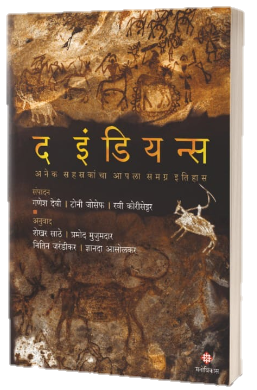SubEditor – Maryam Sayyed
GranthParichay – Shraddha Kumbhojkar
The book ‘The Indians‘ makes a strong research statement. It takes on the responsibility of narrating the history of South Asia over the past twelve thousand years, which corresponds to the Holocene epoch. A total of 105 scholars, each an expert in their respective fields, have contributed articles to this book, drawing on their extensive experience and following rigorous research methodologies to discuss the changes in human life in the Indian subcontinent during this period. This book, written with academic discipline and adhering to the principles of scientific research, is a valuable reference for scholars of South Asian history. In fact, writing with research discipline on a subject in which one has specialized training should not be considered particularly remarkable.
However, since history is a subject closely tied to people’s identities and sentiments, it has become common for those without proper training to make statements about history, share messages and images, and accept narratives that align with their identities as true. This has led to the trivialization of knowledge. The knowledge produced by someone who has devoted their entire life to study is often undervalued. While the Sanskrit saying Swadeshe pujyate raja, vidwan sarvatra pujyate (“A king is revered in his own land, a scholar everywhere”) holds, society tends to accept information that aligns with preconceived notions rather than true scholarship. Writing history based on credible evidence, verifying its authenticity, has become rare. Hence, I feel grateful for the opportunity to contribute an article to this book, which follows strict research methodology.
The central government formed a committee to write the history of the Indian subcontinent for the past twelve thousand years. However, this committee does not include anyone from south of the Narmada River, no women, and no people from religions other than Hinduism. Surprisingly, despite being entrusted with such an important task, this committee has not published even a single line since its formation in 2017.Between 2019-2020, three years after the committee’s formation, its membership increased, but no progress was made in writing history. In such a situation, Prof. Devi took on the responsibility of doing what the central government’s committee should have done. Not only did they undertake this task, but they also completed it within four years, publishing a scientifically written history of the last twelve thousand years. Naturally, it became highly popular, with multiple editions selling out quickly.
“History is like the world in moonlight. We interpret the ten percent of it we can see in our own way,” said Prof. Devi at the Marathi edition’s release event. Prof. Devi and their colleagues, aware of history’s uncertain and evolving nature, began translating the book into four languages to ensure it reached various segments of society. The Marathi translation was published on August 24. As a Marathi reader, there are many reasons to take special pride in this. Many Marathi authors have contributed to this book. It is commendable that so many Marathi historians are included among the best scholars worldwide. Famous books written in English often take years to be available in Marathi. Manovikas Prakashan has undertaken this effort. More importantly, there was a time when there was open discussion and debate on academic subjects among Marathi writers and readers. For example, in the book Bharatiya Samaj Ani Sanskruti (Indian Society and Culture), Prof. M.A. Mehendale compiled scholarly letters as articles in response to various articles published in Navbharat. This tradition of robust debate seems to have dwindled in recent times. People are increasingly resorting to physical confrontation instead of intellectual discourse. Not all the authors of this book share identical views, but the beauty of research lies in presenting what one sees. If another researcher sees something different, the dialogue continues, with each researcher presenting their points. Through The Indians, a step has been taken in the direction of such dialogue.
In this context, as both a writer of one of the articles in this book and a reader of many others, I believe Marathi readers should welcome this book, critique what they find problematic with reasoned arguments, and enjoy the new insights it offers.





